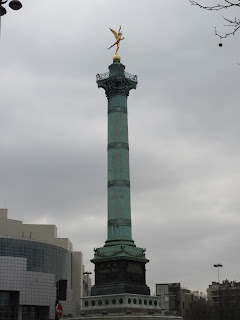 This
was the route that French protestors have marched since the Bastille was torn
down in 1789. In France, protests are not
a rare occasion but a normal, sometimes even daily, event. This is a big difference between France and
the U.S. as there are not very many protests in America, but this is just the
way of French people. The French learned this public protesting from its revolution and this right of the people to voice their opinion through revolt has remained with them. The French
revolution was basically a revolt of the poor lower class against the
wealthy royalty. The French have no problem voicing their opinion since this is how
they know they can do it. It was
interesting to walk this route and imagine the protestors marching down the
street. The Republique is known to be
included in the route whether it is at the beginning or the end but in my case it was at the
beginning of the walk. This statue was
built in 1883 and symbolizes the French Republic that was restored for the
third time in 1870. Along the base of
the statue, there are relief sculptures that depict significant events that led
to the Third Republic. This is a statue
that embodies this revolutionist uprising and the new government. I feel like the French probably respect this
statue and get a sense of pride as well as excitement from it because it
represents a successful turn of events that ended in the Third Republic. They probably feel some support from it too if
they are protesting since they know protests before led to a successful new Republic.
This
was the route that French protestors have marched since the Bastille was torn
down in 1789. In France, protests are not
a rare occasion but a normal, sometimes even daily, event. This is a big difference between France and
the U.S. as there are not very many protests in America, but this is just the
way of French people. The French learned this public protesting from its revolution and this right of the people to voice their opinion through revolt has remained with them. The French
revolution was basically a revolt of the poor lower class against the
wealthy royalty. The French have no problem voicing their opinion since this is how
they know they can do it. It was
interesting to walk this route and imagine the protestors marching down the
street. The Republique is known to be
included in the route whether it is at the beginning or the end but in my case it was at the
beginning of the walk. This statue was
built in 1883 and symbolizes the French Republic that was restored for the
third time in 1870. Along the base of
the statue, there are relief sculptures that depict significant events that led
to the Third Republic. This is a statue
that embodies this revolutionist uprising and the new government. I feel like the French probably respect this
statue and get a sense of pride as well as excitement from it because it
represents a successful turn of events that ended in the Third Republic. They probably feel some support from it too if
they are protesting since they know protests before led to a successful new Republic.
Then
down the street from the Republique statue is the large column for the
Bastille. The Place de la Bastille was a
prison that was stormed in 1789 to free prisoners that were held captive by the
crown. The Bastille was a symbol to the
people of the arbitrary king and so they attacked it eventually taking it apart
brick by brick. The column honors those
who fought and died in the July Revolution of 1830. The remains of hundreds of victims rest in
the statue’s base and on the top of it is a bronze statue of Genie of
Liberty.  It makes sense that this spot
would become part of the protestors’ path as it symbolizes this break through
of hard earned freedom. And if the
protestors are fighting for something this spot additionally gives them support
in fighting for it since they know a fight years ago was successful in
receiving the freedom they have today.
It makes sense that this spot
would become part of the protestors’ path as it symbolizes this break through
of hard earned freedom. And if the
protestors are fighting for something this spot additionally gives them support
in fighting for it since they know a fight years ago was successful in
receiving the freedom they have today.
 It makes sense that this spot
would become part of the protestors’ path as it symbolizes this break through
of hard earned freedom. And if the
protestors are fighting for something this spot additionally gives them support
in fighting for it since they know a fight years ago was successful in
receiving the freedom they have today.
It makes sense that this spot
would become part of the protestors’ path as it symbolizes this break through
of hard earned freedom. And if the
protestors are fighting for something this spot additionally gives them support
in fighting for it since they know a fight years ago was successful in
receiving the freedom they have today. 










